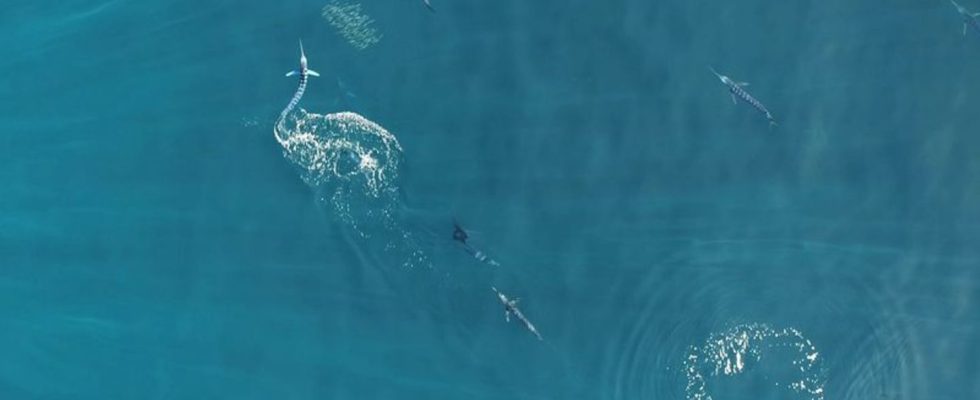Animals
Predatory fish communicate by changing color when hunting
Striped marlin are among the fastest predatory fish in the world. photo
© Alicia Burns/Current Biology/EurekAlert/dpa
Striped marlin are among the fastest predatory fish in the world. A special signal apparently helps them to avoid getting in each other’s way when attacking schools of fish.
The striped marlin’s hunting strategy differs from that of many large land predators. For example, while lions and tigers tend to hunt large prey such as buffalo, wildebeest or zebras, many predatory fish in the water are more interested in small schooling fish such as sardines. Although the striped marlin hunt in groups, they swim individually to attack the school of fish.
Good and reliable coordination of the attacks is important so that they do not injure each other with the spear-like extension of their upper jaw during their quick attacks. The key to this seems to be a rapid color change in the stripes on the marlin’s skin, as researchers from the Humboldt University Berlin and the Leibniz Institute for Freshwater Ecology and Inland Fisheries write, among others.
Signal for the attack
The study was made possible by high-resolution drone footage that shows the predatory fish hunting swarms of sardines from a bird’s eye view. While reviewing the footage, something unexpected stood out: “We found that the attacking marlin ‘lighted up’ and became much brighter than its counterparts during the attack, before quickly reverting to its ‘non-bright’ coloration after the attack,” Alicia Burns from Humboldt University is quoted as saying. This suggests that the color changes could be a reliable signal of an attack.
While marlins had been known to change color before the study, Alicia Burns said this was the first time the behavior had been linked to hunting or other social behavior. “Color changes in predatory fish are rare. And so far, comparatively little attention has been paid to color change in predators.”
The researchers suspect that the color change fulfills various functions and, in addition to coordinating attacks, could also serve to confuse prey. The flashing of the predatory fish could potentially disrupt the collective movement of the school of prey.
Observation from the air
In total, the team examined 12 high-resolution video clips, each showing two separate attacks on a school of sardines by two different marlin. The attacking marlin switch their stripes to bright shortly before the attack – thus increasing the contrast. The peak value could be observed during contact with the prey. Immediately after the attack, the predatory fish reduce the intensity of the stripes again.
Even when individual fish were isolated from the school and attacked by marlin, a discoloration of the stripes was observed in the predatory fish, although this was significantly weaker than in the attacks on the school. “The color change could be more important when attacking prey in a swarm, as the attacks last longer than pursuing isolated prey and therefore there is a higher risk of being interrupted by competitors,” the researchers suspect.

